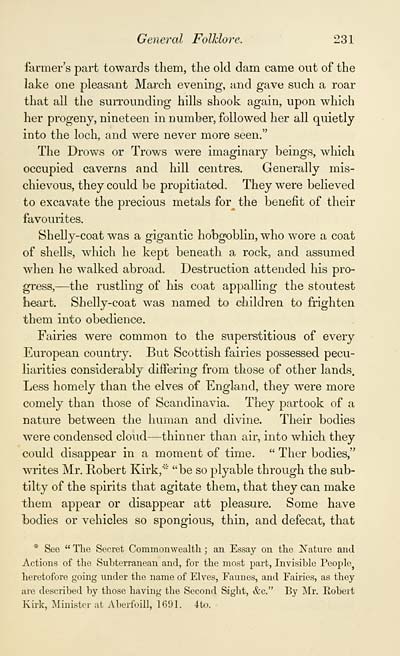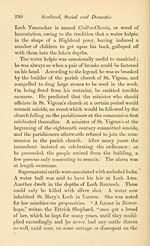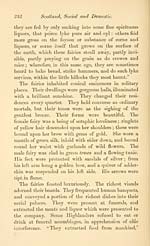Grampian Club > Scotland, social and domestic
(237) Page 231
Download files
Complete book:
Individual page:
Thumbnail gallery: Grid view | List view

General Folklore. 231
farmer's part towards them, the old dam came out of the
lake one pleasant March evening, and gave such a roar
that all the surrounding hills shook again, upon which
her progeny, nineteen in number, followed her all quietly
into the loch, and were never more seen."
The Drows or Trows were imaginary beings, which
occupied caverns and hill centres. Generally mis-
chievous, they could be propitiated.. They were believed
to excavate the precious metals for the benefit of their
favourites.
Shelly-coat was a gigantic hobgoblin, who wore a coat
of shells, which he kept beneath a rock, and assumed
when he walked abroad. Destruction attended his pro-
gress, — the rustling of his coat appalling the stoutest
heart. Shelly-coat was named to children to frighten
them into obedience.
Fairies were common to the superstitious of every
European country. But Scottish fairies possessed pecu-
liarities considerably differing from those of other lands.
Less homely than the elves of England, they were more
comely than those of Scandinavia. They partook of a
nature between the human and divine. Their bodies
were condensed cloud — thinner than air, into which they
could disappear in a moment of time. " Ther bodies,"
writes Mr. Robert Kirk,* "be so plyable through the sub-
tilty of the spirits that agitate them, that they can make
them appear or disappear att pleasure. Some have
bodies or vehicles so spongious, thin, and defecat, that
* See " The Secret Commonwealth ; an Essay on the Nature and
Actions of the Subterranean and, for the most part, Invisible People,
heretofore going under the name of Elves, Faunes, and Fairies, as they
are described by those having the Second Sight, &c." By Mr. Robert
Kirk, Minister at Aberfoill, 1691. 4to.
farmer's part towards them, the old dam came out of the
lake one pleasant March evening, and gave such a roar
that all the surrounding hills shook again, upon which
her progeny, nineteen in number, followed her all quietly
into the loch, and were never more seen."
The Drows or Trows were imaginary beings, which
occupied caverns and hill centres. Generally mis-
chievous, they could be propitiated.. They were believed
to excavate the precious metals for the benefit of their
favourites.
Shelly-coat was a gigantic hobgoblin, who wore a coat
of shells, which he kept beneath a rock, and assumed
when he walked abroad. Destruction attended his pro-
gress, — the rustling of his coat appalling the stoutest
heart. Shelly-coat was named to children to frighten
them into obedience.
Fairies were common to the superstitious of every
European country. But Scottish fairies possessed pecu-
liarities considerably differing from those of other lands.
Less homely than the elves of England, they were more
comely than those of Scandinavia. They partook of a
nature between the human and divine. Their bodies
were condensed cloud — thinner than air, into which they
could disappear in a moment of time. " Ther bodies,"
writes Mr. Robert Kirk,* "be so plyable through the sub-
tilty of the spirits that agitate them, that they can make
them appear or disappear att pleasure. Some have
bodies or vehicles so spongious, thin, and defecat, that
* See " The Secret Commonwealth ; an Essay on the Nature and
Actions of the Subterranean and, for the most part, Invisible People,
heretofore going under the name of Elves, Faunes, and Fairies, as they
are described by those having the Second Sight, &c." By Mr. Robert
Kirk, Minister at Aberfoill, 1691. 4to.
Set display mode to: Large image | Transcription
Images and transcriptions on this page, including medium image downloads, may be used under the Creative Commons Attribution 4.0 International Licence unless otherwise stated. ![]()
| Publications by Scottish clubs > Grampian Club > Scotland, social and domestic > (237) Page 231 |
|---|
| Permanent URL | https://digital.nls.uk/81899528 |
|---|
| Description | Note: Numbers 24-41 are relative to but not part of the Club's series. |
|---|---|

